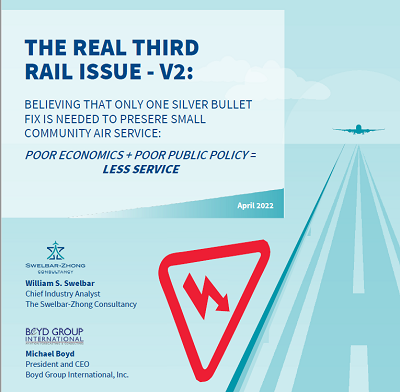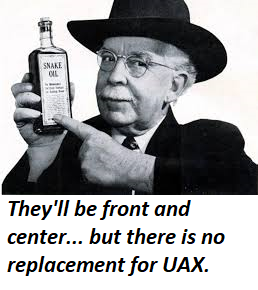Small Community Air Service Access…
It’s An Economic Issue… Not A Pilot Issue. And It’s Not Always At The Local Aerodrome.
We are excited to issue an update to Swelbar-Zhong/Boyd Group analysis of the Essential Air Service Program, and of the pressing need for new approaches to assuring all areas of the nation are communicatively connected to the rest of the world. The thinking and the assumptions underpinning the EAS program are actually holding the nation back from this goal.
We’ll recap a couple of hard foundational facts.
Look! Up in the blue! It’s what you don’t see anymore, but were blackening the skies when the EAS program was conceived.
Beech 99s, Piper Navajos, Metro-IIIs, Embraer-110s, Embraer-120s, J-31s, J-41s, Casa-212s, CV-600s, CV-580s, Beech 1900s, D-328s, D-228s, G-ICs, – literally several hundred small airliners – aren’t there anymore.
Neither are Wings West, Precision, Air Oregon, Metro, Permian, Cochise, Midstates, Britt, Air Illinois, Big Sky, PBA, Bar Harbor, Cascade, Air-LA, Ransome, Air New Orleans, Royale, Aeromech – to name a few.
 In pre-deregulation times, each of those “regional airlines” had their own route systems… operated independently… ran point-to-point, had multi-stop routings like the Nebraska “river run” – OMA-LNK-GRI-LBF-BFF-DEN, and actually carried people on aircraft like those mentioned above.
In pre-deregulation times, each of those “regional airlines” had their own route systems… operated independently… ran point-to-point, had multi-stop routings like the Nebraska “river run” – OMA-LNK-GRI-LBF-BFF-DEN, and actually carried people on aircraft like those mentioned above.
They set their own fares and schedules. There was an interline system that they could connect to at various big cities, to carriers like Continental, Northwest, Ozark, TWA, Republic, Rio, Piedmont, Ozark, Southern
This was the air transportation system which the EAS system is based on. It no longer exists. But EAS does.
Take a gander: air transportation and its role has evolved, based on advancements and complete changes in the entire communications system. No point in getting into how and why of how this evolved. It’s now reality.
This is the core fallacy of the EAS system. The nation needs federal programs that are consistent and compatible with the future. To be sure, some of that may involve financial support for certain air service situations. But it’s funding for economic development around our airport system that now should take priority.
Clarifying – We’re Just The Messenger. After the first edition of the Third Rail, we wanted to address some of the misconceptions the document seemed to generate. Actually, since the document challenged traditional DOT thinking, not to mention threatened a bunch of consultant rice bowls, push-back was not unexpected. Questioning the status quo tends to get some hackles raised.
We’re just the messenger, not advocates. We enthusiastically support airport economic development. Small airports actually have a strong set of new opportunities in the new aviation environment.
All we are pointing out is that EAS and the assumptions behind it are the equivalent of getting a garden hose to extinguish the Hindenburg. It’s an air transportation policy that is a gigantic misfire and failure. The whole EAS enchilada in its current form is an embarrassing waste of money.
Let’s Check The Calendar. Summing up, there simply is no question that while communication channels, and air transportation economics, and consumer patterns have completely evolved in the past 40 years, the EAS program is a policy relic of the 1970s, and has in many cases become an expensive support system for local civic hubris, instead of air access.
It’s Not A Pilot Shortage Issue. Another false belief: it’s just “the pilot shortage” that is causing reductions in small community air service. Were it not for that, all would be well.
That is complete hogwash.
In most cases, it’s raw economics and often the availability of alternative better consumer options. Just hoping for more pilots to come along and restore uneconomic service to small airports is nonsense. Pilot resources are a part of the economic mix, but cockpit crews can be lined up around the building and it won’t bring air service to these airports that don’t generate enough traffic to fill a stretched Ford Econoline van.
It’s Access… Not “Commercial Service.” Worse, today, small communities and their civic leaders are increasingly being sold the malarkey that “commercial service” is simply a factor like “running water” or a sewer system. The goal is to just get scheduled flights, without much concern whether they connect to anything or can even compete with existing consumer-available alternatives. In fact, those are factors that are typically ignored – or sidetracked – in most ASD approaches.
Two Caravans A Day Is Not “Air Access.” The argument is that without commercial service at the local airport, the community is cut off from economic growth. That’s ridiculous, when the “service” might be two flights a day, with questionable connectivity, even with small jet service. And while the operators involved do a great job, it gets more outlandish when the options are a couple of single-engine Cessna 408s. The argument that such service is “better than nothing” is weak. It is essentially nothing in regard to air service access.
SkyWest/UAX Was The High Point. It’s Not Coming Back. This transition will be particularly challenging for the 29 airports where SkyWest/United Express is leaving town.
 Too many communities are being convinced that just getting another carrier will do the trick. That’s a couple notches short of ethical behavior. Communities need to be informed of and understand what they are facing. The UAX service was part and parcel of the global United Airlines system. An independently-branded carrier replacement that might have T&B agreements with a couple of majors isn’t 10% of the exposure of air access that was provided by the SkyWest/UAX program.
Too many communities are being convinced that just getting another carrier will do the trick. That’s a couple notches short of ethical behavior. Communities need to be informed of and understand what they are facing. The UAX service was part and parcel of the global United Airlines system. An independently-branded carrier replacement that might have T&B agreements with a couple of majors isn’t 10% of the exposure of air access that was provided by the SkyWest/UAX program.
With this update of the Third Rail Thought Paper, we’ve made the point that EAS – and by similar arguments, the SCASD program – must be completely re-structured to address consumer realities, not the 1970s. Re-direct those millions of dollars into programs to encourage business growth and next-generation aviation support.
These are not “conclusions.” They are recognition of realities that are going to continue to manifest.
For A Copy of The Third Rail Thought Paper, click here. For communities and airports that are interested in exploring how the new aviation industry may offer economic opportunities, let us at BGI or Swelbar-Zhong know.
We’re looking at the future. And we’re not concerned with political correctness.
________________